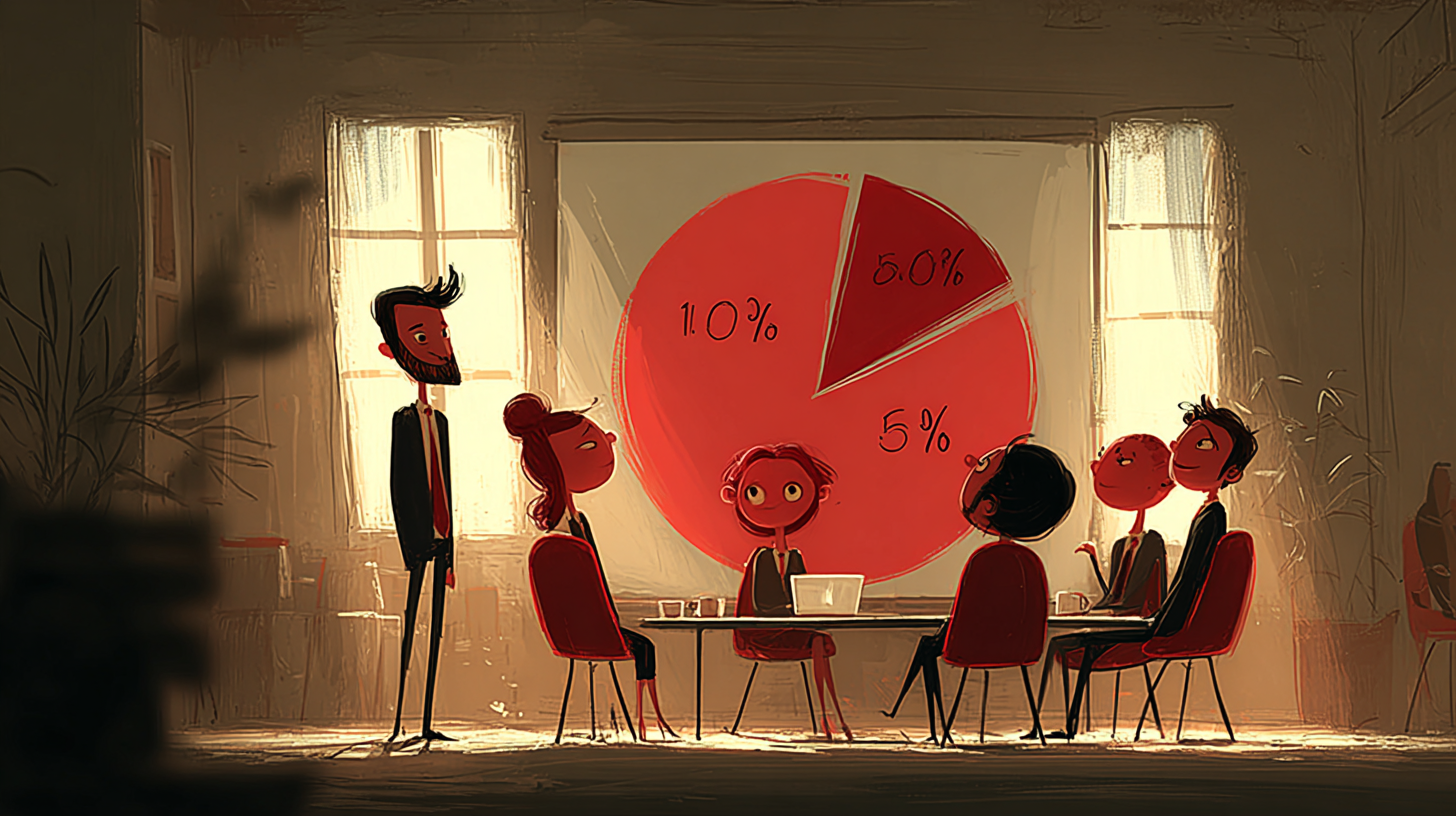“Percent” means “a part out of 100.”
「percent」は「100のうちのいくつか」という意味。
以下は英単語 “percent” に関するストーリー型学習コンテンツです。まずは大枠の意味を理解して最後の文章で確認しましょう。
主な意味(main meaning)
| 品詞 | 発音記号 (IPA) | 意味 | 英語例文 |
|---|---|---|---|
| 名詞 (noun) | /pərˈsɛnt/ | 100のうちの一部、割合 | Ten percent of the students were absent. |
| 副詞 (adverb) | /pərˈsɛnt/ | ~の割合で | The price increased 20 percent last year. |
語源(etymology)
「percent」はラテン語の per centum(100につき)から来ています。
核となるイメージは「100を基準にした割合」です。
類義語(synonyms)
| 類義語 | 意味 | 例文 |
|---|---|---|
| proportion | 割合 | The proportion of women in the class is high. |
| ratio | 比率 | The ratio of men to women is two to one. |
| fraction | 分数、部分 | Only a small fraction of the money was used. |
| share | 分け前、割合 | He took his share of the profit. |
反義語(antonyms)
| 反義語 | 意味 | 例文 |
|---|---|---|
| whole | 全体 | We need to consider the whole picture, not just a percent. |
| total | 合計 | The total is more important than a single percent. |
コロケーション(collocations)
| コロケーション | 例文 |
|---|---|
| ten percent | Ten percent of the employees are new. |
| high percent | A high percent of people like coffee. |
| low percent | Only a low percent of students failed the test. |
| percent increase | There was a five percent increase in sales. |
| percent chance | There is a 70 percent chance of rain tomorrow. |
2項表現(binomials)
| 2項表現 | 例文 |
|---|---|
| give and take | Life is full of give and take. |
| black and white | The rule is written in black and white. |
英語ストーリー(english story)
Story (English)
At BrightTech Company, the manager, Ms. Rivera, was preparing a report on employee satisfaction. She explained to her team, “According to our survey, ten percent of the employees are unhappy with their work environment. That may sound like a small number, but we cannot ignore it.”
James, a young employee, raised his hand. “What is the proportion of workers who feel satisfied?”
Ms. Rivera replied, “About eighty-five percent are satisfied, and five percent are neutral. So, if we look at the ratio, the happy workers greatly outnumber the unhappy ones. Still, even a small fraction of unhappy employees can influence the whole atmosphere of the office.”
Another team member added, “I think we should compare the results with last year. Was there a percent increase in dissatisfaction?”
“Yes,” Ms. Rivera nodded. “There was a two percent increase. Last year only eight percent were unhappy. If we continue like this, it could become a problem.”
James thought for a moment. “So, we should not only focus on the percent, but also on the whole situation. For example, what are the main reasons for dissatisfaction?”
“That’s a very good point,” Ms. Rivera agreed. “We must look at the total picture. Numbers are important, but we also need to understand feelings.”
The discussion continued. They talked about possible solutions. Some said the company should improve communication. Others suggested flexible working hours. There was a lot of give and take during the meeting.
Finally, Ms. Rivera said, “We cannot see the world only in black and white. Some problems are complicated. But if we work together, we can find the right balance. Even if a high percent of people are satisfied, our goal is one hundred percent.”
Everyone nodded. They knew that even though the numbers looked good, real success meant listening carefully to every voice in the company.
和訳
ブライトテック社で、リベラ課長は従業員の満足度についての報告を準備していました。彼女はチームに説明しました。「調査によると、従業員の**10 percent(パーセント=割合)**が職場環境に不満を持っています。小さな数字に見えるかもしれませんが、無視できません。」
若手社員のジェームズが手を挙げました。「満足している人の**proportion(プロポーション=割合)**はどのくらいですか?」
リベラ課長は答えました。「約85 percentが満足していて、5 percentは中立です。つまり**ratio(レシオ=比率)を見ると、満足している人が不満な人を大きく上回っています。しかし、小さなfraction(フラクション=部分)**の不満でも、職場全体の雰囲気に影響します。」
別のチームメンバーが言いました。「去年と比べてみるべきです。不満の**percent increase(パーセントの増加)**はありましたか?」
「はい、2 percent増加しました。去年は8 percentだけでした。このままでは問題になるかもしれません。」
ジェームズは考えて言いました。「だから、percentだけではなく、**whole(ホール=全体)**を見るべきです。不満の主な理由は何ですか?」
「その通りです。」とリベラ課長。「数字も大事ですが、**total(トータル=合計)**の状況を見ることも必要です。」
議論は続きました。コミュニケーション改善を提案する人もいれば、柔軟な勤務時間を提案する人もいました。会議は多くの**give and take(ギブ・アンド・テイク=持ちつ持たれつ)**で進みました。
最後にリベラ課長が言いました。「物事を**black and white(ブラック・アンド・ホワイト=白黒はっきり)**だけで見ることはできません。問題は複雑です。でも協力すれば正しいバランスが見つかります。たとえ多くの人が満足していても、私たちの目標は100 percentです。」
全員がうなずきました。数字が良く見えても、本当の成功は従業員一人ひとりの声に耳を傾けることだと分かっていたのです。
Q&A
Q: 「percent」と「proportion」はどう違いますか?
A: 「percent」は100を基準にした割合を表します(例: 10%)。「proportion」は全体に対する部分の大きさや比率を示す、より広い意味の言葉です。
Q: 「percent」と「ratio」の違いは?
A: 「percent」は100の中での割合を指します。「ratio」は二つ以上の数の比較(例: 2:1 のような比)を表します。
Q: 「percent」と「fraction」はどう違いますか?
A: 「percent」は100分率に限定されますが、「fraction」は1/2, 3/4 のように「分数」や「一部」を表すことができます。
Q: 「percent」と「share」の違いは?
A: 「percent」は数量の割合を表すのに使いますが、「share」は「取り分」や「分担」という意味合いが強く、人や物に分け与えられる部分を指します。
Q: 「percent」と「whole」はどう違いますか?
A: 「percent」は部分を表すのに対し、「whole」は「全体」を強調する言葉です。部分と全体の対比になります。
Q: 「percent」と「total」の違いは?
A: 「percent」は「100のうちの一部」ですが、「total」は「合計」や「全部の数」を表します。全体像を数としてまとめるときに使います。
Q: 「percent」と「high percent」「low percent」はどう違いますか?
A: 「percent」は中立的な割合の表現ですが、「high percent」「low percent」は「高い割合」「低い割合」と、程度を示す点で違います。
Q: 「percent」と「percent increase」は違いますか?
A: はい。「percent」は単なる割合ですが、「percent increase」は「何パーセント増えたか」という「変化の度合い」を示します。
Q: 「percent」と「percent chance」はどう違いますか?
A: 「percent」は数字の割合ですが、「percent chance」は「起こる可能性の割合(確率)」を意味します。
このように見ると、「percent」は数字的に100を基準にした「割合」ですが、他の単語は「比率」「分け前」「全体」「増加」「確率」など、それぞれニュアンスが異なります。



コメント